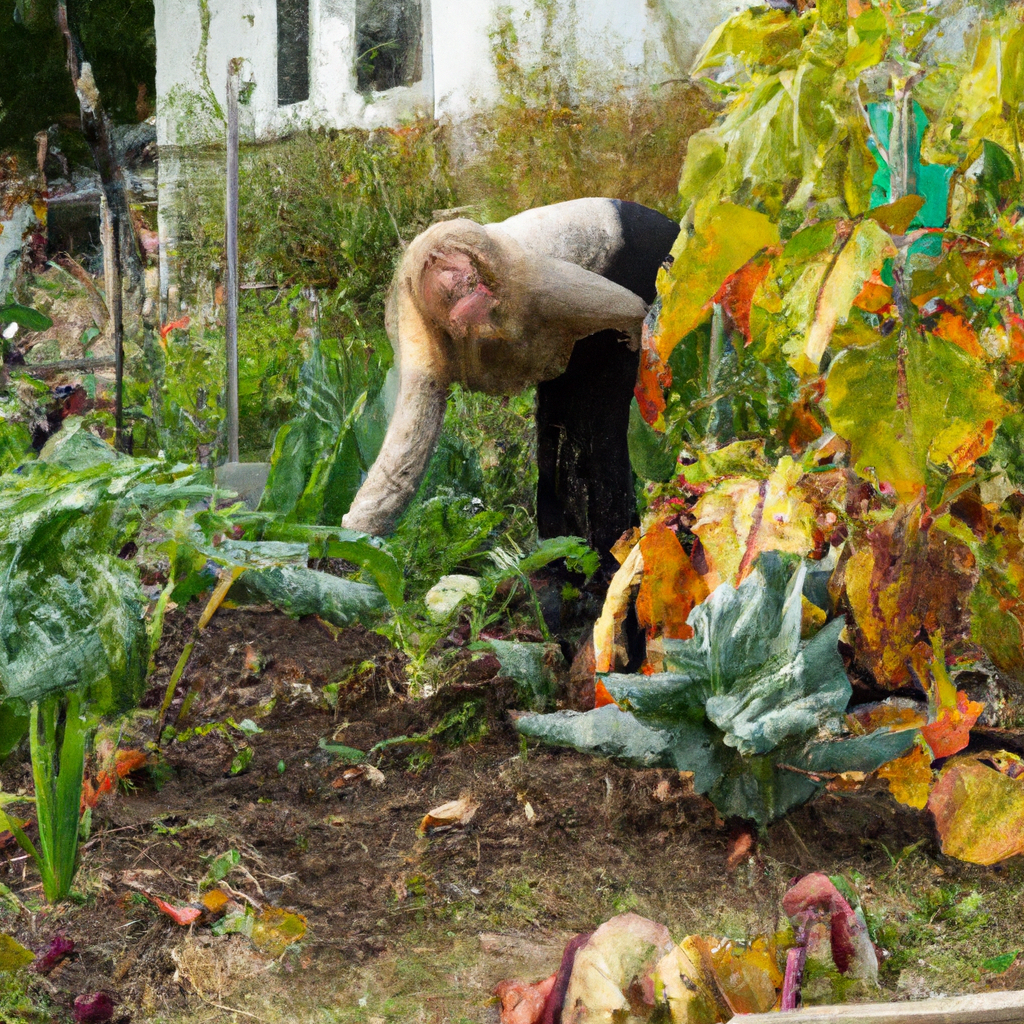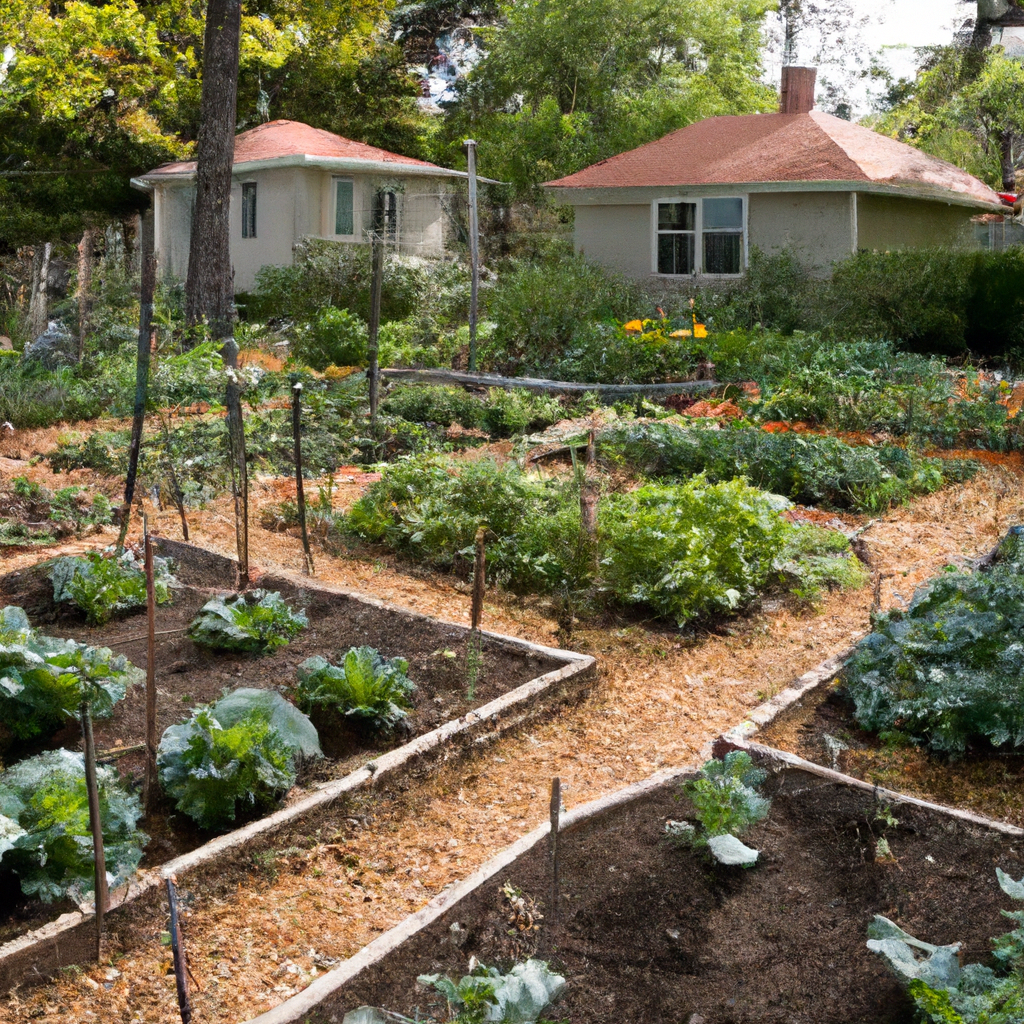
Imagine living in a neighborhood where neighbors come together to dig in the dirt, plant seeds, and cultivate an oasis of green in the urban jungle. Community gardens have become a symbol of unity and resilience, offering a space where people from all walks of life can connect, learn, and grow together. Beyond mere patches of greenery, these gardens hold the power to strengthen bonds, promote healthy living, and foster a sense of belonging that can transform entire communities. In this article, we will explore the transformative power of community gardens and the multitude of benefits they bring to individuals and neighborhoods alike.

Benefits of Community Gardens
Improves physical and mental health
Community gardens offer numerous benefits to both physical and mental health. Engaging in gardening activities, such as planting, weeding, and harvesting, provides an opportunity for individuals to engage in physical exercise which helps improve overall fitness levels. Additionally, spending time outdoors and being surrounded by nature can have a positive impact on mental well-being, reducing stress and anxiety. The act of gardening itself has been found to be therapeutic, allowing individuals to find solace and relaxation while tending to the plants.
Promotes environmental sustainability
Community gardens play a crucial role in promoting environmental sustainability. By cultivating plants and growing their own food, community gardeners contribute to a reduction in carbon emissions caused by the transportation of produce. Additionally, community gardens often implement sustainable gardening practices such as composting, rainwater harvesting, and avoiding the use of harmful chemicals. These practices not only minimize harm to the environment but also serve as educational opportunities to raise awareness about sustainable living.
Enhances social connections
One of the most significant benefits of community gardens is the enhancement of social connections. These gardens provide a shared space where people from different backgrounds and walks of life can come together, united by a common interest in gardening. It fosters a sense of community and belonging, creating opportunities for interaction, collaboration, and the exchange of knowledge and experiences. The bonds formed in community gardens often extend beyond the garden gates, resulting in lasting friendships and wider social networks.
Educational opportunities for all ages
Community gardens offer a wealth of educational opportunities for people of all ages. From teaching gardening skills to promoting environmental awareness, these gardens act as outdoor classrooms. Children can learn about the life cycle of plants, the importance of healthy soil, and the basics of sustainable gardening. Adolescents and adults can participate in workshops and learn about topics like organic gardening, permaculture, and natural pest control. Additionally, community gardens often partner with local schools to provide educational programs, allowing students to learn hands-on about sustainable food production and the environment.
Creating and Maintaining a Community Garden
Choosing a suitable location
Selecting a suitable location for a community garden is paramount to its success. A sunny area with access to water and proper drainage is essential for plant growth. Take into consideration factors such as proximity to the community, safety, and available space. Engage with local authorities, community leaders, and residents to identify potential locations and ensure that the community garden will integrate seamlessly with the neighborhood.
Organizing a group
Before embarking on the creation of a community garden, it is crucial to organize a group of dedicated individuals who share a passion for gardening and community development. Reach out to friends, neighbors, and local organizations to gauge interest and recruit volunteers. Establish regular meetings to discuss goals, responsibilities, and the vision for the garden. Building a strong and committed group will provide the foundation for the success and longevity of the community garden.
Designing the garden layout
Designing an efficient and well-thought-out garden layout is key to maximizing space and optimizing the gardening experience. Consider factors such as pathways, raised beds, and seating areas, ensuring that the garden is accessible to all members of the community. Engage with group members and seek their input on the design, allowing for a collaborative approach that reflects the needs and desires of the community. Additionally, incorporate spaces for communal activities and social gatherings, fostering a sense of community and enjoyment within the garden.
Acquiring necessary resources
Once the group has identified a suitable location and finalized the garden layout, it is essential to acquire the necessary resources to bring the garden to life. Seek donations of gardening tools, soil, seeds, and plants from local businesses, organizations, and community members. Apply for grants and explore fundraising opportunities to secure financial resources for purchasing additional supplies and materials. By mobilizing the community, you can ensure that the necessary resources are available to create and sustain the garden.
Establishing maintenance practices
Establishing maintenance practices is crucial to ensuring the longevity and success of the community garden. Assign responsibilities to group members, such as watering, weeding, and composting, and create a schedule to ensure that all tasks are completed regularly. Implement a system for garden plot assignments, allowing community members to take ownership of their individual spaces. Organize workdays where volunteers come together to tackle larger tasks and maintain the overall beauty and functionality of the garden. By establishing a culture of maintenance, the community garden will flourish and continue to thrive.

Engaging the Community
Promoting awareness and participation
Promoting awareness and encouraging community participation are key elements in the success of a community garden. Utilize various channels to spread the word about the garden, such as social media, community bulletin boards, and local newsletters. Host informational sessions and open houses to showcase the garden and educate community members about its goals and benefits. Additionally, engage with local schools, retirement homes, and religious institutions to involve diverse groups within the community. By actively promoting the garden, you can spark interest and inspire others to become involved.
Involving local businesses and organizations
Engaging local businesses and organizations can provide valuable support to the community garden. Reach out to garden centers, nurseries, and hardware stores to establish partnerships and explore opportunities for in-kind donations or discounted prices on gardening supplies. Collaborate with local restaurants, farmers markets, and grocery stores to establish a market for excess produce or to host fundraising events. Additionally, consider partnerships with environmental organizations or community development groups to further expand the impact and reach of the community garden.
Hosting workshops and events
Hosting workshops and events in the community garden not only educate and engage community members but also create opportunities for social connections. Offer gardening workshops on topics such as seed starting, composting, and container gardening. Organize cooking demonstrations and nutrition workshops to promote healthy eating habits and the use of fresh produce. Celebrate harvest festivals and organize community potlucks to bring people together and showcase the fruits of their labor. By hosting these events, the community garden becomes not only a place for growing food but also a vibrant social hub within the community.
Encouraging community collaboration
Encouraging community collaboration is key to building a strong and united community garden. Foster a sense of ownership among gardeners by encouraging them to contribute ideas, share knowledge, and collaborate on garden projects. Establish a communal plot where surplus produce can be shared with those in need. Encourage intergenerational learning and mentorship, where experienced gardeners can pass on their knowledge to younger members of the community. By cultivating a culture of collaboration, the community garden becomes a true reflection and embodiment of community spirit.
Addressing Food Insecurity
Improving access to fresh, affordable produce
Community gardens play a vital role in improving access to fresh and affordable produce, particularly in underserved communities where access to healthy food options may be limited. By growing their own food or purchasing from community garden markets, residents have access to nutritious and locally sourced produce, reducing their reliance on expensive and often processed supermarket options. Additionally, the act of growing food empowers individuals to take control of their own nutrition and develop a deeper appreciation for the value of fresh, wholesome produce.
Providing food for vulnerable populations
Community gardens can be instrumental in providing food for vulnerable populations, such as low-income individuals, seniors, and homeless communities. By partnering with local food banks and shelters, excess produce from the garden can be donated to those in need, ensuring that even the most vulnerable members of the community have access to fresh and nutritious food. Such initiatives not only address immediate food needs but also contribute to long-term food security and resilience within the community.
Collaborating with food banks and shelters
Collaborating with local food banks and shelters can help community gardens expand their impact and provide even greater support to those in need. Establish relationships with these organizations, and develop systems for regular donations of surplus produce. Work with them to identify specific needs and help address any gaps in the availability of fresh produce. By forging these partnerships, community gardens can serve as valuable contributors to local food security initiatives and create a more equitable food system.
Educating community members on nutrition and healthy eating
Community gardens provide an ideal platform for educating community members about nutrition and healthy eating. Organize workshops, cooking demonstrations, and nutrition classes where experts can share their knowledge and teach individuals how to make the most of fresh produce. Encourage community members to grow and cook their own food, empowering them to make healthier choices and promoting self-sufficiency. By equipping individuals with the knowledge and skills to make informed decisions about their diet, community gardens contribute to improved health outcomes and overall well-being.

Supporting Environmental Sustainability
Reducing food waste
One significant way community gardens support environmental sustainability is by reducing food waste. In traditional food systems, significant amounts of produce are discarded due to cosmetic imperfections or overproduction. However, in community gardens, these surplus fruits and vegetables can be harvested and shared with the community, minimizing food waste. Additionally, the organic waste generated in community gardens can be composted and used as a natural fertilizer, closing the loop and reducing the need for harmful synthetic alternatives.
Preserving biodiversity
Community gardens contribute to the preservation of biodiversity by cultivating a wide variety of plant species. Traditional agriculture often prioritizes a limited number of commercial crops, resulting in a loss of biodiversity. However, community gardens embrace the cultivation of heirloom, indigenous, and lesser-known plant varieties, thereby preserving traditional seed biodiversity. By actively protecting and promoting the diversity of plants within the garden, community gardens become vital havens for plant species while also maintaining crucial ecosystems and habitats.
Improving soil quality
The act of gardening itself helps improve soil quality, and community gardens are no exception. By implementing sustainable gardening practices such as composting and mulching, community gardens enrich the soil with organic matter, enhancing its fertility and structure. This results in healthier plants with increased resistance to pests and diseases. Additionally, community gardens often prioritize the use of organic and natural fertilizers, minimizing the reliance on chemical-based alternatives that can harm the environment and deplete soil health over time.
Promoting sustainable gardening practices
Community gardens are at the forefront of promoting sustainable gardening practices. Through workshops and educational programs, individuals can learn about concepts such as organic gardening, permaculture, and water conservation. Community gardens often encourage the use of environmentally friendly pest control methods, such as attracting beneficial insects and practicing crop rotation. By promoting these sustainable practices, community gardens serve as models for sustainable living and inspire individuals to adopt similar approaches in their own gardening endeavors.
Social and Community Benefits
Fostering social interactions
Community gardens provide a space for individuals to come together and foster social interactions. Whether it’s chatting with fellow gardeners while tending to plants or engaging in group activities and events, community gardens serve as a natural catalyst for socializing. Friendships are formed, and a sense of camaraderie develops as people share their love for gardening and nature. The regular interactions within the community garden create a close-knit community where individuals support and uplift one another.
Creating a sense of belonging
A sense of belonging is essential for individuals to feel connected and engaged within their community. Community gardens provide a unique opportunity to create this sense of belonging by fostering a shared space and purpose. Members of the community garden have a place they can call their own, where they can contribute, learn, and make a difference. This feeling of ownership and belonging enhances overall well-being and encourages individuals to take an active role in the broader community.
Increasing community cohesion
Community gardens act as catalysts for increased community cohesion. By bringing together individuals from diverse backgrounds and walks of life, community gardens create a sense of unity and shared purpose. The act of working together towards a common goal, such as maintaining the garden or organizing events, builds trust and strengthens relationships within the community. As community members collaborate and support one another, bonds are formed, and a stronger and more resilient community emerges.
Strengthening community resilience
Community gardens contribute to the resilience of communities by fostering a sense of self-sufficiency and empowerment. By growing their own food and sharing resources, community members become less reliant on external food systems and gain a greater sense of control over their own well-being. Additionally, community gardens often serve as spaces for education and skill-building, equipping individuals with the knowledge and tools to adapt to challenges and contribute to the overall resilience of the community.

Educational Opportunities
Teaching gardening skills
Community gardens provide an excellent opportunity to teach gardening skills to individuals of all ages. Experienced gardeners can mentor beginners, sharing their knowledge and expertise. Gardening workshops and demonstrations can cover topics ranging from basic gardening techniques to advanced practices such as organic pest control and companion planting. By imparting these skills, community gardens empower individuals to cultivate their own gardens and contribute to sustainable food production.
Promoting environmental awareness
Educating community members about the environment and the importance of sustainable living is a crucial role of community gardens. Workshops, lectures, and educational materials can raise awareness about issues such as climate change, biodiversity loss, and water conservation. By sharing this knowledge within the community garden, individuals become more conscious of their impact on the environment and are motivated to make sustainable choices in their daily lives.
Offering school programs
Community gardens often partner with local schools to offer educational programs for students. These programs provide hands-on learning experiences, allowing students to connect with nature, learn about plant life cycles, and appreciate the importance of healthy food. By engaging students in age-appropriate activities such as planting seeds, tending to plants, and harvesting produce, community gardens foster a love for the environment and instill values of sustainability from an early age.
Developing intergenerational learning
Community gardens offer opportunities for intergenerational learning, where individuals of different ages learn from and with each other. Children can benefit from the expertise and wisdom of older gardeners, while seniors can learn from the fresh perspectives and enthusiasm of younger individuals. By creating spaces for intergenerational learning, community gardens foster a sense of respect for one another and contribute to the transmission of traditional gardening knowledge from one generation to the next.
Addressing Urban Issues
Revitalizing vacant lots
Community gardens have the power to revitalize vacant and underutilized lots within urban areas. These neglected spaces can be transformed into beautiful, productive gardens, bringing life and vitality to the surrounding neighborhoods. By investing time and effort into the creation of a community garden, these once desolate areas become spaces that inspire and bring joy to community members. The transformation of vacant lots into thriving gardens can become a source of community pride and a catalyst for further urban revitalization.
Mitigating urban heat island effect
Urban areas often experience higher temperatures due to the urban heat island effect, resulting from the abundance of concrete and asphalt that absorb and radiate heat. Community gardens can help mitigate this effect by replacing concrete with green spaces that provide shade and evaporative cooling. The presence of trees, plants, and gardens creates a microclimate that helps reduce temperatures, making the surrounding neighborhood more pleasant and comfortable for residents.
Improving air quality
Community gardens contribute to improved air quality in urban areas. Through the process of photosynthesis, plants absorb carbon dioxide and release oxygen, helping to cleanse the air of pollutants and reduce greenhouse gas emissions. The addition of green spaces and plants in community gardens can help filter out pollutants and create healthier air for residents to breathe. This improved air quality has a positive impact on the overall well-being and quality of life within the community.
Enhancing aesthetics of the neighborhood
Well-maintained and visually appealing community gardens enhance the overall aesthetics of a neighborhood. By transforming vacant lots or neglected spaces into vibrant and thriving green havens, community gardens create visually appealing landscapes that beautify the surrounding area. The presence of plants, flowers, and well-designed garden layouts adds color, texture, and visual interest to the neighborhood, making it a more inviting and pleasant place to live and visit.

Overcoming Challenges
Securing funding and resources
One of the main challenges in creating and maintaining a community garden is securing funding and resources. Community gardens often rely on grants, partnerships, and donations to acquire essential supplies, tools, and materials. To overcome this challenge, it is crucial to establish strong relationships with local businesses, organizations, and governmental agencies. Seek opportunities for financial support through grant applications, fundraising events, and crowdfunding platforms. Additionally, explore possibilities for in-kind donations and engage in community outreach to generate support and generate resources for the garden.
Managing conflicts and disagreements
As with any community endeavor, conflicts and disagreements can arise within a community garden. Differing opinions on garden management, plot assignments, and maintenance practices can lead to tensions among members. To address these challenges, it is essential to foster a culture of open communication and active listening. Establish clear guidelines and protocols for conflict resolution, and encourage members to express their concerns and ideas in a respectful and constructive manner. By promoting a culture of collaboration and understanding, conflicts can be addressed and resolved, ensuring a harmonious community garden environment.
Dealing with limited space
Limited space can be a significant challenge when creating a community garden, particularly in dense urban areas. However, with careful planning and creative design, it is possible to maximize the use of available space. Utilize techniques such as vertical gardening, container gardening, and raised beds to make the most of limited land. Engage in community partnerships to explore the possibility of shared spaces or rooftop gardens. By thinking outside the box and utilizing innovative gardening methods, even small and confined spaces can be transformed into productive and thriving community gardens.
Handling gardening pests and diseases
Gardening pests and diseases are a common challenge faced by community gardeners. It is important to implement sustainable pest management practices to minimize the use of harmful chemicals and maintain a healthy garden ecosystem. Encourage the use of natural pest control methods such as companion planting, predator insects, and physical barriers. Regular monitoring and early detection of pests and diseases can help prevent infestations and minimize damage to plants. Establish a culture of knowledge sharing, where gardeners can learn from each other’s experiences and collectively address pest and disease challenges.
Case Studies of Successful Community Gardens
Urban Farming in Detroit, Michigan
In response to urban blight and food insecurity, urban farming initiatives have flourished in Detroit, Michigan. Organizations such as The Greening of Detroit have transformed vacant lots into productive urban farms and community gardens. These initiatives not only provide fresh and affordable produce to local residents but also offer employment and job training opportunities. The urban farming movement in Detroit has become a source of community pride, inspiring individuals to transform their neighborhoods and create sustainable food systems.
The High Line Park in New York City
The High Line Park in New York City is a remarkable example of the transformation of an abandoned railway into a vibrant urban garden. This elevated park features a lush landscape with a wide variety of plant species, highlighting the importance of biodiversity in urban environments. The High Line Park has become a beloved community space where locals and tourists alike can enjoy nature, art installations, and stunning views of the city. This innovative project demonstrates the power of community gardens in reimagining urban spaces and creating vibrant public parks.
Keukenhof Gardens in Lisse, Netherlands
Keukenhof Gardens in Lisse, Netherlands, is one of the world’s most renowned community gardens. Each year, millions of visitors flock to witness the breathtaking displays of colorful spring flowers, including tulips, daffodils, and hyacinths. Keukenhof Gardens showcases the beauty and diversity of flowers, acting as an educational and inspiring destination for individuals of all ages. This community garden demonstrates the ability of plant communities to create awe-inspiring landscapes that attract visitors from around the world.
The Rooftop Gardens of Singapore
Singapore, known for its limited land area, has embraced the concept of rooftop gardens as a solution to urban greening. Rooftop gardens, such as those found on shopping malls and commercial buildings, provide a unique opportunity to create green spaces in densely populated urban areas. These gardens not only contribute to the aesthetic appeal of the city but also help mitigate the urban heat island effect and improve air quality. The rooftop gardens of Singapore showcase the innovation and creativity that can be achieved when communities and businesses work together to green their urban landscapes.
In conclusion, community gardens offer numerous benefits to individuals and communities, ranging from physical and mental health improvements to environmental sustainability and educational opportunities. Creating and maintaining a successful community garden involves careful planning, organization, and engagement with the community. By addressing challenges and promoting collaboration, community gardens can become transformative spaces that enhance the well-being and resilience of communities. The case studies of successful community gardens highlight the impact and potential of these initiatives in revitalizing urban areas and connecting people with nature. Thus, community gardens have the power to positively transform communities, foster social connections, and create a healthier and more sustainable future.





